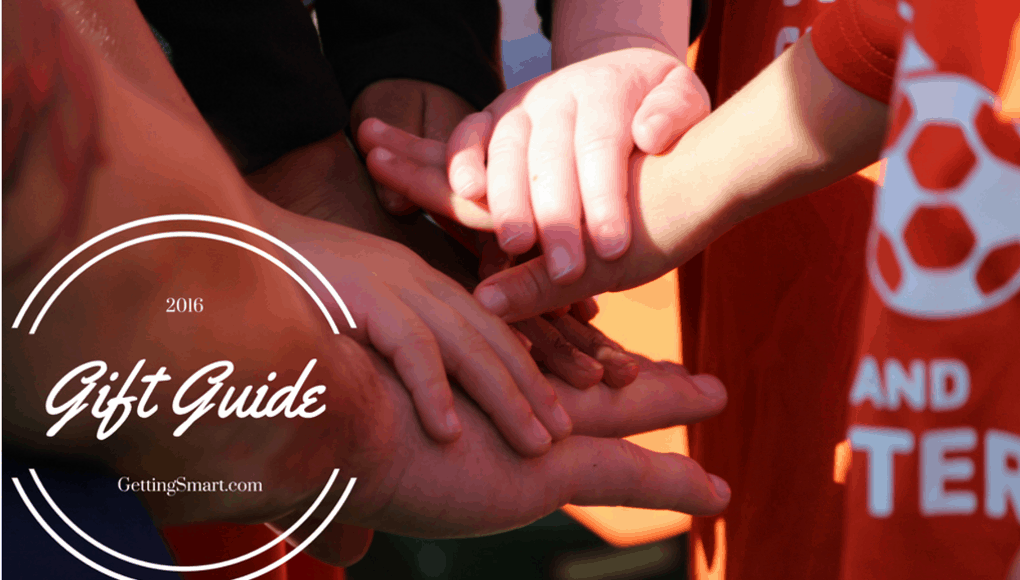Getting Smart Gift Guide | 10 Gifts that Teach SEL

Wondering about fun ways to spread kindness, set a positive tone at home (or in the classroom) and teach SEL skills—and have fun doing so? How about also checking off a gift list item while you’re at it?
Team Getting Smart knows that prioritizing SEL is important, but we also recognize that it can be hard to do. Which is why we created a list of some of our favorite toys, books and apps that foster social emotional learning. This is not intended to be an exhaustive list, so please add your ideas to the comment section below.
Let us start by saying some of the best gifts we can give our children (students, sons, daughters, friends) is the gift of time. Simply being present for, encouraging or offering to play with kids is a gift in and of itself.
1. Inside Out (Movie | all ages). This year, Pixar melted our hearts once more with a film that gets you right in the feels by teaching kids and adults to recognize and honor their emotions. Here are 12 ideas on how to use the movie Inside Out to Teach SEL and get through life’s ups and downs. For an added bonus stock up on the book set as well.
2. “What to Do When __________. “ (Book | upper elementary through middle school). Magination Press has published a series of “What to Do Guides” (e.g. What to Do When You Worry Too Much, What to Do When Your Temper Flares) that come in a graphic-friendly workbook. The books include strategies for kids (and adults!) to apply when they feel angry, worried, stuck and/or downright grumpy.
3. Happify. (App | middle school and up). This app walks kids and parents through activities that are “de-stressors.” Thanks to Happify, games such as “Negative Knockout” provide fun ways to practice gratitude, learning breathing techniques and enjoy a sense of calm. Happify is targeted primarily towards adults, so this is best for older kids.
4. Worry Woos. (Books + stuffed animals | birth – elementary ) The WorryWoos book series and accompanying stuffed animals make emotions real for kids in such a way that make them excited about expressing their feelings.
5. Cooperative Games. (Games | all ages): Rather than focusing on the competition, cooperative games, like Forbidden Island (ages 10 – 12) and Race to the Treasure (ages 5 – 8) are great ways to build collaboration and teamwork as they require teams to work together to problem solve. They encourage and teach valuing a variety of perspectives and utilizing individual contributions to achieve success as a team.
6. Lego Today I Feel Emotion Chart (Printable | elementary): This free printable from And Next Comes L allows kids to practice identifying how they are feeling, which in turn will support personal well-being and relationship building.
7. Worry Eaters. (Stuffed animal | preschool – elementary): The zippered mouths of these worry eaters are designed to gobble up kids’ concerns all well teach kids how to better communicate and develop effective coping methods. Kids write or draw their worries and concerns and place them in the worry eaters mouth (a zipper pocket) — imagine these as the next generation of worry dolls.
8. Daniel Tiger’s Grr-ific Feelings. (App | Preschool): This free app from PBS Kids lets kids explore feelings through games, drawing, songs and even a photo booth that helps them connect facial expressions to the way they are feeling.
9. American Girl WellieWishers. (Toys | upper elementary): The WellieWishers are a group of dolls who, just like the traditional American Girls, each have a storyline of their own (and enough accessories to keep plenty busy). However, they are a little different in that the focus of these girls is a dedication and commitment to being good friends.
10. Children’s Books. (Books | all ages): There is no shortage of children’s books that focus on feelings and the qualities of becoming a good friend or a confident individual. Books like Spaghetti In A Hot Dog Bun, My Many Colored Days, Stick and Stone, What if Everybody Did That and Rude Cakes are great ways to ignite powerful conversations with kids. The adults might learn some helpful tips as well.
As stated earlier, nothing can replace the time we have with our students, families, friends and our own children. We don’t have to buy things in order to promote the teaching of social and emotional learning, and we can do this through the intentional gift of our time and attention to one another, our families and students. A dinner table conversation, a fun game of questions, an art project or playing a game together can bring about an opportunity to promote collaboration, cooperation, executive functioning skills, negotiation and more.
For more, see:
- Kid Tested, Smart Parent Approved Toys and Games
- How Two Minutes of SEL Can Change the Tone for the Day
- 12 Ways to Use Inside Out to Teach SEL, STEM, and Life’s Ups & Downs
Stay in-the-know with all things EdTech and innovations in learning by signing up to receive the weekly Smart Update. This post includes mentions of a Getting Smart partner. For a full list of partners, affiliate organizations and all other disclosures, please see our Partner page.



0 Comments
Leave a Comment
Your email address will not be published. All fields are required.